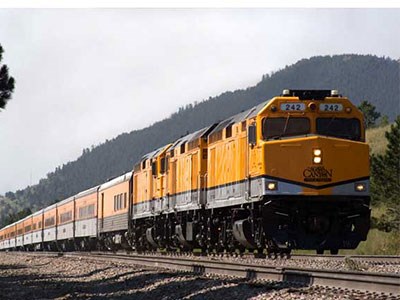Just as Sault Ste. Marie was experiencing a nice upswing in U.S. Ridership on the Agawa Canyon Tour Train, the city received a blow in early September when dramatic flooding washed out significant rail infrastructure, delaying the start of the tour train season by two weeks.
A day-long excursion that brings visitors through the Agawa Canyon to experience the changing fall colours, the tour is the Sault’s biggest economic driver of the tourism industry.
But heavy rain caused massive flooding across the region, damaging critical rail infrastructure, including washing out a bridge over the Root River directly in the path of the tour train.
The train starts running in mid-September when the colours are just starting to turn and goes until after Thanksgiving weekend. The 770-seat passenger train wasn’t sold out at the time of the flooding, but the loss was still considerable, said Ian McMillan, executive director of Tourism Sault Ste. Marie.
“It wasn’t the worst of times that it could have occurred, but it wasn’t the best either,” McMillan said, noting the last two weeks of the season are the most popular. “We probably lost, we’re thinking, somewhere in the neighbourhood of 6,000 riders over that two-week period, which is a fairly significant economic impact on the community.”
An economic impact of $2 million, in fact.
The average rider spends two nights in the community, injecting money into accommodations, retail outlets, restaurants and bars, and secondary attractions like the Canadian Bushplane Heritage Centre. It’s difficult to make up that loss, McMillan said, as many of the later dates, when colours are at their peak, sell out early.
Some guests were able to reschedule their dates, but others couldn’t as their vacation schedules were already set. Tourism Sault Ste. Marie worked overtime contacting guests who made their reservations online to offer them full refunds.
They also came up with some creative ways to accommodate those who were part of a group tour. For one, arrangements were made to take a guided bus tour along Lake Superior up to Wawa, have lunch in Wawa and make stops along the way.
“That drive from Sault Ste. Marie up to Wawa and Thunder Bay is always represented as one of the top 10 drives in Canada,” McMillan said.
Prior to the security crackdown in the U.S., 65 per cent of the train’s traffic hailed from the U.S. Today, 65 per cent is from Ontario, 30 per cent is American, and the rest is comprised of national and international traffic.
“We have seen, in the last few years, an upswing of Chinese-Japanese travel on the train, but mostly new Canadians out of the GTA, not so much right from Japan or China,” McMillan said.
This marked the first year Tourism Sault Ste. Marie worked with a Korean tour operator that flew passengers from Korea to Chicago, and then bussed them to Sault Ste. Marie.
The operator was “quite pleased” with the number of trips that were sold, which was “encouraging,” McMillan said. In Ontario, the biggest markets remain Toronto, Waterloo, Kitchener, and London, while in the U.S., Michigan, Wisconsin, Ohio, Indiana, and Illinois provide the most tourists.
Over the last two years, the Sault has been experiencing an increase in American traffic following a 10-year decline.
Acknowledging the economic impact of the tour train to Sault Ste. Marie’s economy, CN worked around the clock to get repairs done. By the third week of September, the train was up and running again.
Described as an anomaly, the heavy rain and flooding aren’t anticipated to cause problems in the future, but McMillan is confident if it does happen, CN and the city will be prepared.
“They’ve done massive repairs to that location and put in appropriate safeguards, so that if a large flood ever occurs it would not have the same consequences as it did this time,” he said. “Barring some unforeseen natural disaster, I don’t see worrying too much about a lengthy cancellation of the train for a stretch.”




